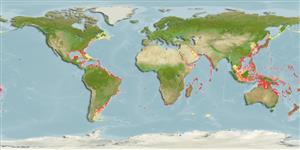Common names from other countries
Classification / Names / Names
ชื่อสามัญ | ชื่อพ้อง | Catalog of Fishes (gen., sp.) | ITIS | CoL | WoRMS
Environment: milieu / climate zone / depth range / distribution range
นิเวศวิทยา
; ระดับความลึก 0 - 60 m (Ref. 7727). Tropical
Circumglobal tropical and temperate seas; Found in all warm water.
Length at first maturity / ขนาด / น้ำหนัก / Age
Maturity: Lm ? range ? - ? cm Max length : 30.0 cm TL เพศผู้/กระเทย; (Ref. 126605); น้ำหนักสูงสุดที่มีการรายงาน: 468.00 g (Ref. 126605); อายุสูงสุดที่ได้รายงาน: 1.00 ปี (Ref. 126605)
Maximum depth from Ref,. 109264. Sea hares have annual life cycles (Ref. 126605). Also found in the shallow subtidal. Nocturnal species (Ref. 844). Hides in crevices within the day (Ref. 866). Known from depths of 0 to 20 m (Ref. 7727). Come inshore during March and April to lay its eggs (Ref. 125338).
Life cycle and mating behavior
วัยเจริญพันธุ์ | การสืบพันธุ์ | การวางไข่ | เซลสืบพันธ์ของเพศเมีย(ไข่) | ความดกของไข่ | ตัวอ่อน
Members of the order Anaspidea are mostly simultaneous hermaphrodites (Ref. 833). Come inshore during March and April to lay its eggs. Copulation goes from several hours to several days. Once the eggs are laid, the adults return to shallow waters to die (Ref. 125338).
Debelius, H. 2001. (Ref. 844)
IUCN Red List Status (Ref. 130435)
CITES status (Ref. 108899)
Not Evaluated
Not Evaluated
Human uses
| FishSource |
เครื่องมือ
ข้อมูลเพิ่มเติม
Age/SizeการเจริญเติบโตLength-weightLength-lengthสัณฐานวิทยาตัวอ่อนอุดมสมบรูณ์
แหล่งที่มาจากอินเตอร์เน็ต
Estimates based on models
Preferred temperature
(Ref.
115969): 14.8 - 28.7, mean 26.5 (based on 1346 cells).
Vulnerability
Low vulnerability (10 of 100).
Price category
Unknown.
